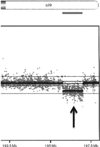A clinical case report and literature review of the 3q29 microdeletion syndrome
- PMID: 25714563
- PMCID: PMC5125389
- DOI: 10.1097/MCD.0000000000000077
A clinical case report and literature review of the 3q29 microdeletion syndrome
Abstract
We report on a 15-year-old male with the 3q29 microdeletion syndrome and summarize the medical literature. He had intellectual disability, autism spectrum disorder, anxiety, obsessive compulsive tendencies, speech delay, delayed walking, a hypernasal voice, gait abnormalities, chronic constipation, gastroesophageal reflux disorder, urinary voiding dysfunction, abnormal skin pigmentation, and dysmorphic features. We present a review of the literature for the 3q29 microdeletion syndrome by comparing both the phenotype and the genetic defects in reported cases. Of the 38 previously reported cases with deletion size information, the most common chromosome deletion was 1.6 Mb in size including ∼ 30 genes. This emerging microdeletion syndrome is characterized by intellectual disability, speech delay, behavioral problems, craniofacial dysmorphism, and musculoskeletal abnormalities.
Conflict of interest statement
There are no conflicts of interest.
Figures


References
-
- Baynam G, Goldblatt J, Townshend S. A case of 3q29 microdeletion with novel features and a review of cytogenetically visible terminal 3q deletions. Clin Dysmorphol. 2006;15:145–148. - PubMed
-
- Città S, Buono S, Greco D, Barone C, Alfei E, Bulgheroni S, et al. 3q29 microdeletion syndrome: cognitive and behavioral phenotype in four patients. Am J Med Genet A. 2013;161A:3018–3022. - PubMed
-
- Clayton-Smith J, Giblin C, Smith RA, Dunn C, Willatt L. Familial 3q29 microdeletion syndrome providing further evidence of involvement of the 3q29 region in bipolar disorder. Clin Dysmorphol. 2010;19:128–132. - PubMed
-
- Cobb W, Anderson A, Turner C, Hoffman RD, Schonberg S, Levin SW. 1.3 Mb de novo deletion in chromosome band 3q29 associated with normal intelligence in a child. Eur J Med Genet. 2010;53:415–418. - PubMed
Publication types
MeSH terms
Supplementary concepts
Grants and funding
LinkOut - more resources
Full Text Sources
Medical
Miscellaneous

